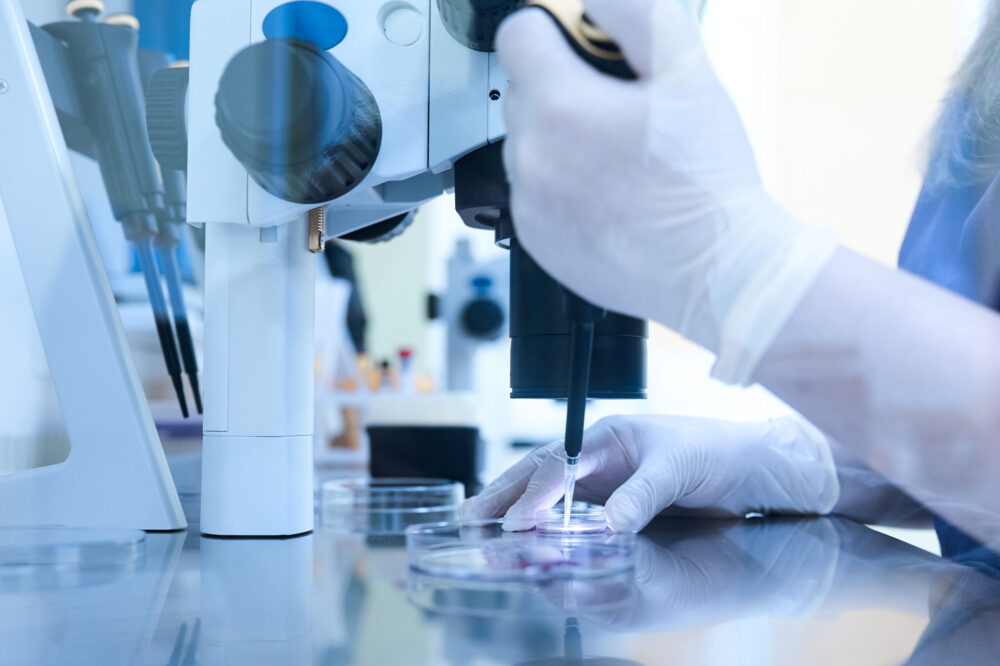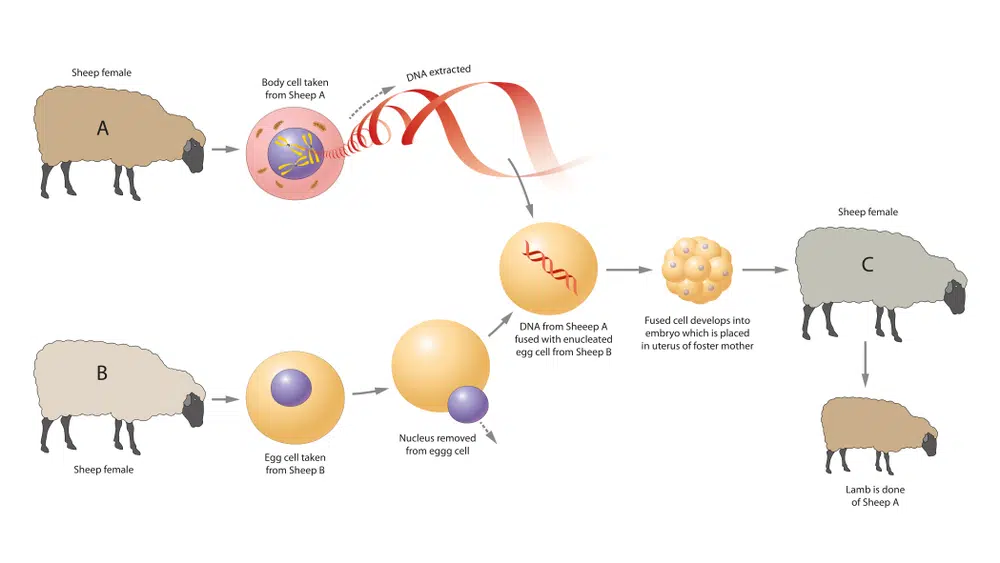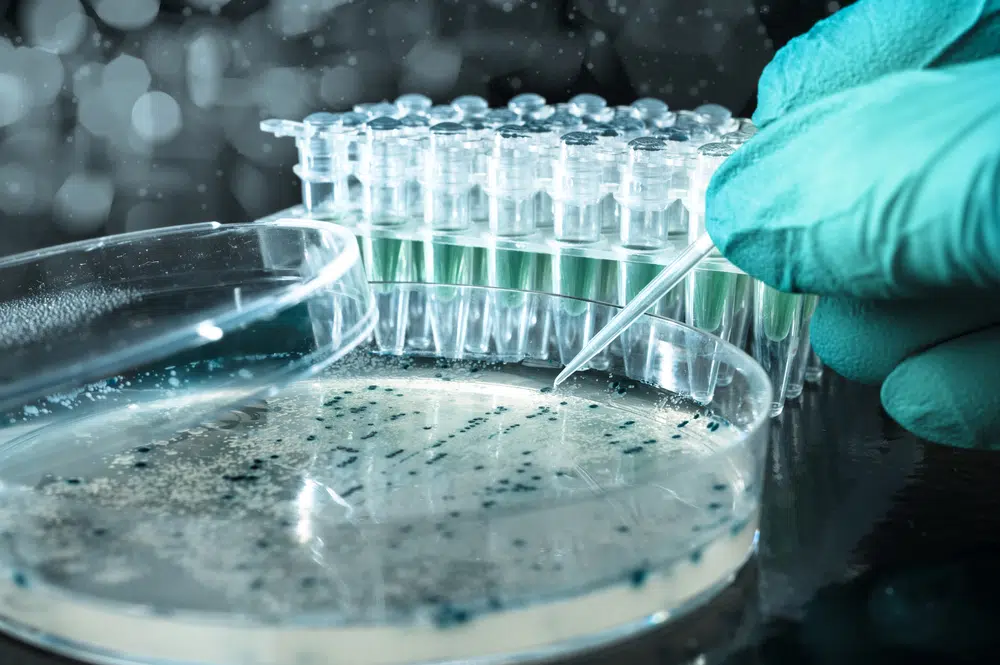For decades, hair transplants have been the gold standard for hair restoration, but hair cloning is the ultimate goal. This revolution can potentially provide unlimited new hair, generating completely new follicles.
Unlike traditional transplants, cloning multiplies hair follicle cells under lab conditions and reintroduces them into the scalp. This could eliminate baldness for good.
With hair cloning human trials already underway, interest is at an all-time high. But when will hair cloning be available?
What Exactly Is Hair Cloning?
Hair cloning is an advanced technique designed to multiply hair follicle cells in a lab and reimplant them into the scalp, potentially creating new hair growth.
It achieves this impressive feat in 3 simple steps:
- Cell Extraction
- Multiplication
- Reimplantation
Unlike hair transplant cloning, which reuses and redistributes existing follicles, true hair cloning aims to generate entirely new follicles, offering an unlimited hair supply.
The Complete 3-Step Procedure
Hair cloning is a multi-step process that extracts, multiplies, and reintroduces hair follicle cells to stimulate new hair growth. Here is how it works:
1. Extraction of Dermal Papilla Cells
The process begins by removing a small sample of dermal papilla cells from the base of healthy hair follicles. These cells regulate hair growth and initiate follicle development.
This step is performed using a biopsy or micro-punch extraction, which means its minimally invasive. The goal is to collect high-quality cells while ensuring minimal damage to the donor area.
2. Cell Culturing & Multiplication
Once extracted, the papilla cells are placed in a lab environment. Scientists use growth factors, nutrients, and special conditions to stimulate these cells and make them reproduce exponentially.
A major challenge is ensuring that lab-grown cells remain functional after multiple divisions. Researchers are refining techniques to maintain their regenerative potential.
3. Reimplantation into the Scalp
After achieving a sufficient number of cloned cells, they are injected back into bald or thinning areas . The goal is for them to integrate with existing tissue and stimulate new follicle formation, leading to natural hair regrowth.
While still in clinical trials, this approach could provide a lifelong solution to hair loss. It would eliminate the donor hair limitations of traditional transplants and make hair restoration accessible to anyone suffering from baldness.
Common Misconception:
Cloning Hair vs. Cloning ‘Dolly the Sheep’
When a sheep like Dolly was cloned, scientists used somatic cell nuclear transfer (SCNT). This worked because an entire organism was grown from a single cell in a controlled lab environment.
Cloning an entire hair follicle in the same way as cloning a sheep is substantially more difficult.
This is because:
- Hair follicles are mini-organs that require a delicate balance of stem cells, dermal papilla cells, and external factors like hormones.
- Duplicating hair follicles through cloning doesn’t guarantee functional hair growth once implanted.
- Current lab techniques canmultiply hair follicle cells, but they struggle to form full, working follicles once reintroduced into the scalp.
Would True Hair Cloning (Like Dolly’s) Be More Effective?
In theory, yes, if we could copy-paste entire new hair follicles into bald areas, that would be the ultimate solution, because:
- It would eliminate donor area limitations, allowing unlimited hair regrowth.
- It could work for completely bald individuals without any remaining hair.
However, science isn’t there yet. Recreating entire, fully functional hair follicles in a lab is a major challenge.
For now, multiplying key follicle cells and stimulating hair growth is the closest thing we have.
Hair Cloning Human Trials: 2025 Latest Updates
As of 2025, significant progress has been made in hair cloning research, with several key developments:
Major Clinical Trials and Studies
Stemson Therapeutics has advanced its proprietary hair rejuvenation solution, successfully creating human hair follicles in humanized mice using engineered follicular units. This milestone brings them closer to initiating human clinical trials.
Aderans Research Institute has conducted Phase 2 clinical testing on a cell therapy system that rejuvenates shrinking hair follicles. Initial data suggest this approach can safely produce durable hair growth.
Current Challenges & Road Ahead
Researchers currently face several obstacles:
- Cell Survival and Functionality: Cultured dermal papilla cells often lose their hair-inducing capabilities outside the body.
- Follicle Formation: Ensuring that multiplied cells organize into fully functional hair follicles remains complex.
- Safety and Efficacy: Extensive clinical trials are needed to confirm that hair cloning is both safe and effective for widespread use.
The Most Recent Breakthroughs
Researchers at Yokohama National University have successfully cloned fully-grown mouse hair follicles, marking a significant step toward potential human applications.
Stemson Therapeutics has demonstrated robust human hair growth in humanized mice, indicating promising prospects for future human trials.
When Will Hair Cloning Be Available?
As of 2025, hair cloning is still in the research phase, but progress is being made. Stemson Therapeutics, one of the leading companies in this field, aim to begin human clinical trials by 2026, which could bring the technology closer to real-world applications.
Another company, HairClone, has already started follicle banking services, allowing individuals to preserve their follicles for future cell-based treatments.
According to industry experts, hair cloning treatments may take another 5-10 years before they become widely available. The biggest hurdles remain cell survival, follicle formation, and regulatory approvals. Researchers remain optimistic, but a commercially viable solution may not be accessible until the 2030s.
Hair Cloning in Turkey
Turkey has long established itself as a global hub for advanced hair loss techniques, including the exploration of hair cloning technologies. Among the leading clinics, Dr. Serkan Aygin’s Clinic stands out for its commitment to innovation.
With over 25 years of experience, awarded ‘Best Hair Transplant Doctor in Europe’ in 2019 by a Paris committee, Dr. Aygin’s team is dedicated to staying abreast of the latest developments, including stem cell hair treatments, using the patient’s own stem cells to stimulate hair growth.
The clinic’s proactive approach ensures that patients benefit from the most effective treatments available.
Dr. Serkan Aygin offers free online consultations, including 3D hair analysis and all-inclusive travel plans for his stem cell hair transplants and autologous hair therapies.
Hair Cloning vs. Hair Transplant Cloning
Traditional hair transplants involve moving healthy hair follicles from the back or sides of the scalp (the donor area) to bald or thinning areas.
These procedures do not create new hair follicles—they redistribute existing ones, making them ineffective for individuals with severe baldness or poor donor areas.
Feature | Hair Cloning | Hair Transplant Cloning |
Creates new hair follicles? | ✅ Yes | ❌ No |
Multiplies hair follicle cells? | ✅ Yes | ⚠️ Partial |
Still relies on a donor area? | ❌ No | ✅ Yes |
Approved for use? | ❌ Not yet (still in trials) | ⚠️ Limited availability |
Potential for unlimited hair? | ✅ Yes | ❌ No |
Best for severe baldness? | ✅ Yes | ❌ No (still requires donor hair) |
In 2025, hair reallocation remains the only proven treatment that successfully reverses hair loss with permanent results.
While it may still take a while for baldness to be history, patients can still opt for a hair transplant in Turkey and access hair restoration at affordable costs.




